
A collection of two cardboard boxes with 21 glass plate negatives in the format 8 x 18 cm. The negatives show images of the mobilisation during the first weeks of the First World War in the city of Nevers in France. Each slide is numbered, and the numbers link to handwritten notes on the boxes. The notes contain the subject and the date of the photograph.
Germany had declared war on France on 3 August 1914. The first photo dates from 9 August, so the war was less than a week old for the French. This makes the collection historically significant because images from the early stages of the First World War are rare. Most images date from the period 1915 to 1918. The fact that the images are stereo negatives in a large 8 x 18 cm format makes this collection unique.
The collection
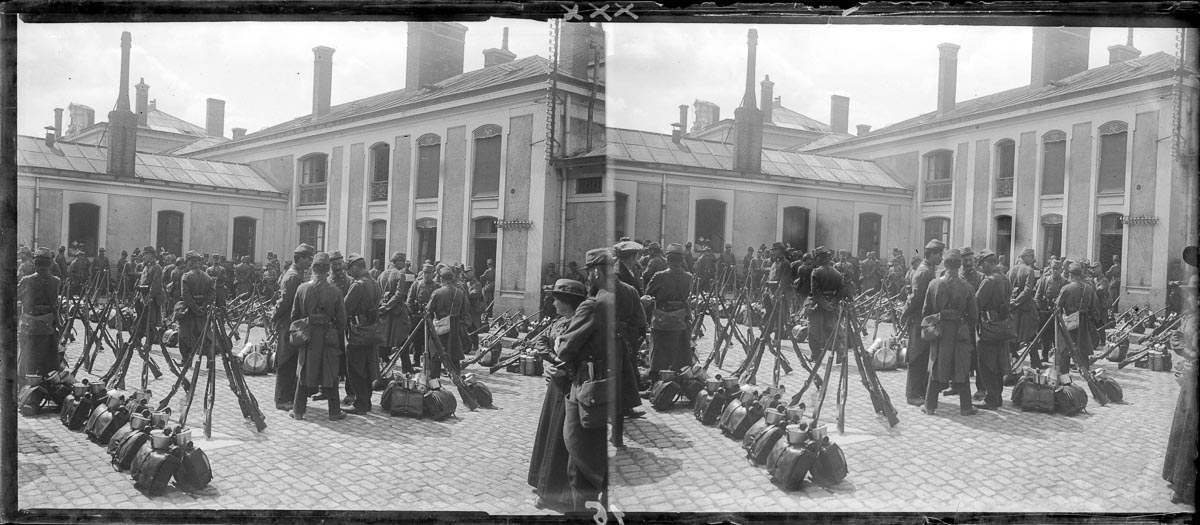
The original collection consisted of 34 negative slides in two boxes, of which four slides were most likely not related to the war. Only 24 slides were offered individually on eBay, so it seems that the collection was no longer complete when it was auctioned. 21 slides were purchased. Unfortunately, I was outbid on three slides, which was disappointing because this collection should have stayed together.
The two cardboard boxes with notes were shown during the auction, but were not part of the sale. Afterwards, I contacted the seller and asked if I could buy the boxes, or get a high resolution scan. The seller was kind enough to offer the boxes for free because I bought most of the negatives.
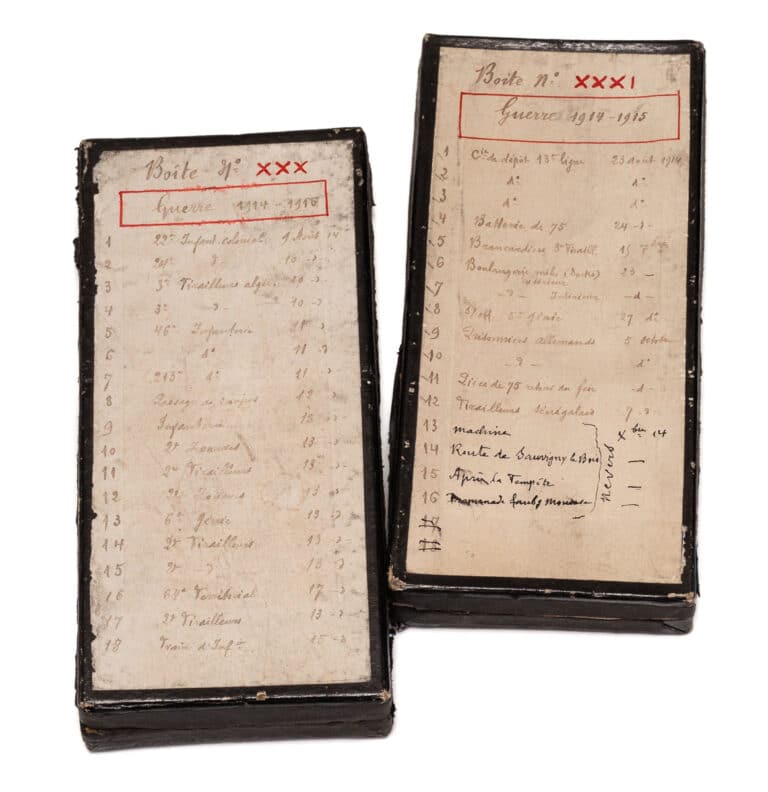
The tables below contain a complete overview of the collection. The handwritten titles on the boxes sometimes contain abbreviations, but are written out in full in the tables. The two boxes are numbered with the Roman numerals XXX and XXXI. It is striking that they bear the titles Guerre 1914–1915 (War 1914–1915). It is consistent with the general expectation that the war would only last a short time. No one could have imagined that the war would continue until the end of 1918.
Box XXX contains 11 slides from the original collection of 18 slides.
| Number | Title | Date | In collection |
| 1 | 22e Infanterie Colonial | 09-08-1914 | Yes |
| 2 | 24e Infanterie Colonial | 10-08-1914 | No |
| 3 | 3e Tirailleurs Algérien | 10-08-1914 | No |
| 4 | 3e Tirailleurs Algérien | 10-08-1914 | Yes |
| 5 | 46e Infanterie | 11-08-1914 | Yes |
| 6 | 46e Infanterie | 11-08-1914 | Yes |
| 7 | 213e Infanterie | 11-08-1914 | Yes |
| 8 | Passage de Soupes | 12-08-1914 | No |
| 9 | Infanterie | 12-08-1914 | Yes |
| 10 | 2e Zouaves | 13-08-1914 | Yes |
| 11 | 2e Tirailleurs | 13-08-1914 | No |
| 12 | 2e Zouaves | 13-08-1914 | No |
| 13 | 6e Génie | 13-08-1914 | No |
| 14 | 2e Tirailleurs | 13-08-1914 | Yes |
| 15 | 2e Tirailleurs | 13-08-1914 | Yes |
| 16 | 64e Territorial | 17-08-1914 | Yes |
| 17 | 2e Tirailleurs | 13-08-1914 | No |
| 18 | Train d’Infanterie | 15-08-1914 | Yes |
Box XXXI contains 10 slides from the original collection of 16 slides. The last four slides are only dated with month and year, and the notes are applied in a different pen colour. The titles suggest other topics that are not related to the war. These notes are also the only ones to contain the location “Nevers”, which helped to track the location of the war images to this city.
| Number | Title | Date | In collection |
| 1 | Compagnie de dépôt 13e ligne | 23-08-1914 | Yes |
| 2 | Compagnie de dépôt 13e ligne | 23-08-1914 | Yes |
| 3 | Compagnie de dépôt 13e ligne | 23-08-1914 | Yes |
| 4 | Batterie de 75 | 24-08-1914 | Yes |
| 5 | Brancardiers 3e Tirailleurs | 07-10-1914 | Yes |
| 6 | Boulangerie Militaire extérieur | 23-08-1914 | No |
| 7 | Boulangerie Militaire intérieur | 23-08-1914 | Yes |
| 8 | Officier 5e génie | 27-08-1914 | Yes |
| 9 | Prissoniers Allemands | 05-10-1914 | Yes |
| 10 | Prissoniers Allemands | 05-10-1914 | Yes |
| 11 | Pièce de 75 retour du feu | 05-10-1914 | Yes |
| 12 | Tirailleurs Sénégalais | 07-10-1914 | No |
| 13 | Machine | October 1914 | No |
| 14 | Route de Sauvigny le Bois | October 1914 | No |
| 15 | Après la Tempête | October 1914 | No |
| 16 | Promenade faubg mou(?) | October 1914 | No |
Nevers
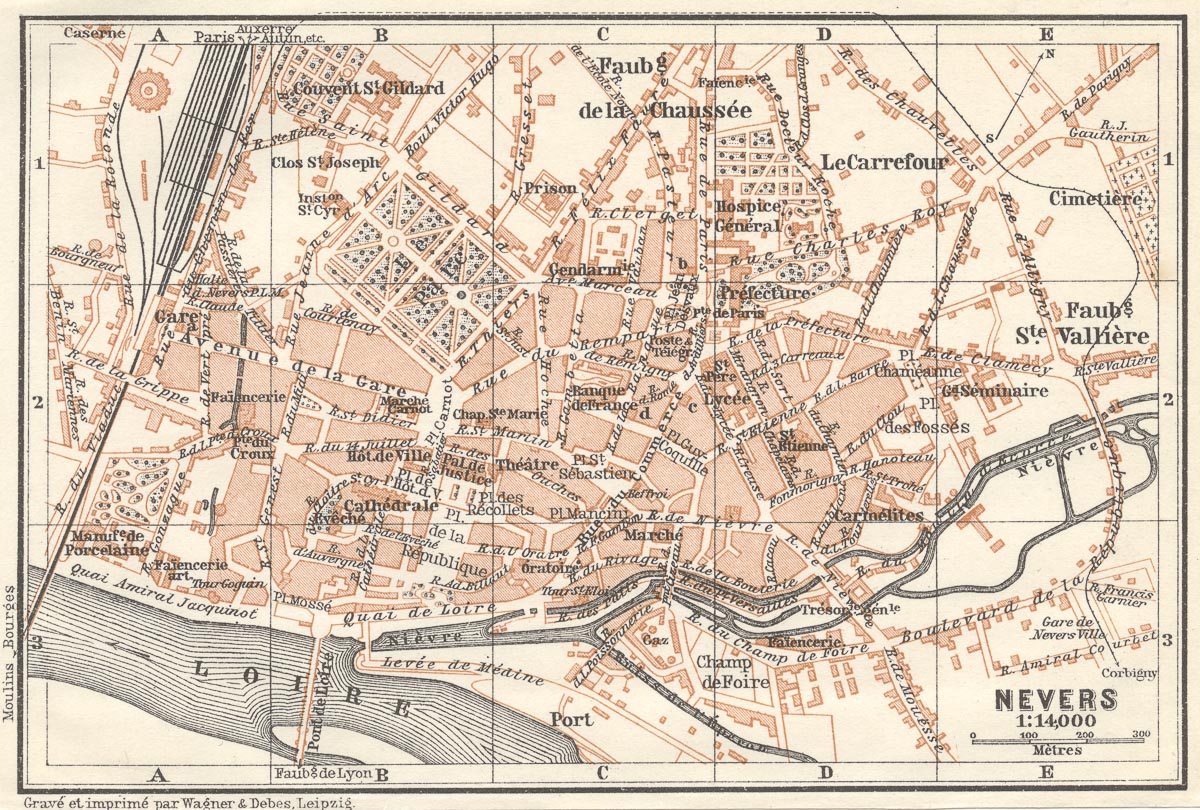
The station is visible in the upper left corner
Nevers is situated on the right bank of the river Loire. The city is the prefecture of the Nièvre department in the Bourgogne-Franche-Comté region in central France. The city had c. 28,000 inhabitants on the eve of the First World War1.
The construction of a railway line that connected the city began in the 1840s. In 1850, the station was inaugurated with the arrival of the first two trains from Paris2. A depot for supplying locomotives was built near the station and was put into service in 18613. The construction of the Atelier du matériel de Nevers began in 1912 and contained workshops for maintaining locomotives and wagons. These facilities ensured that Nevers became an important logistics hub during the war.
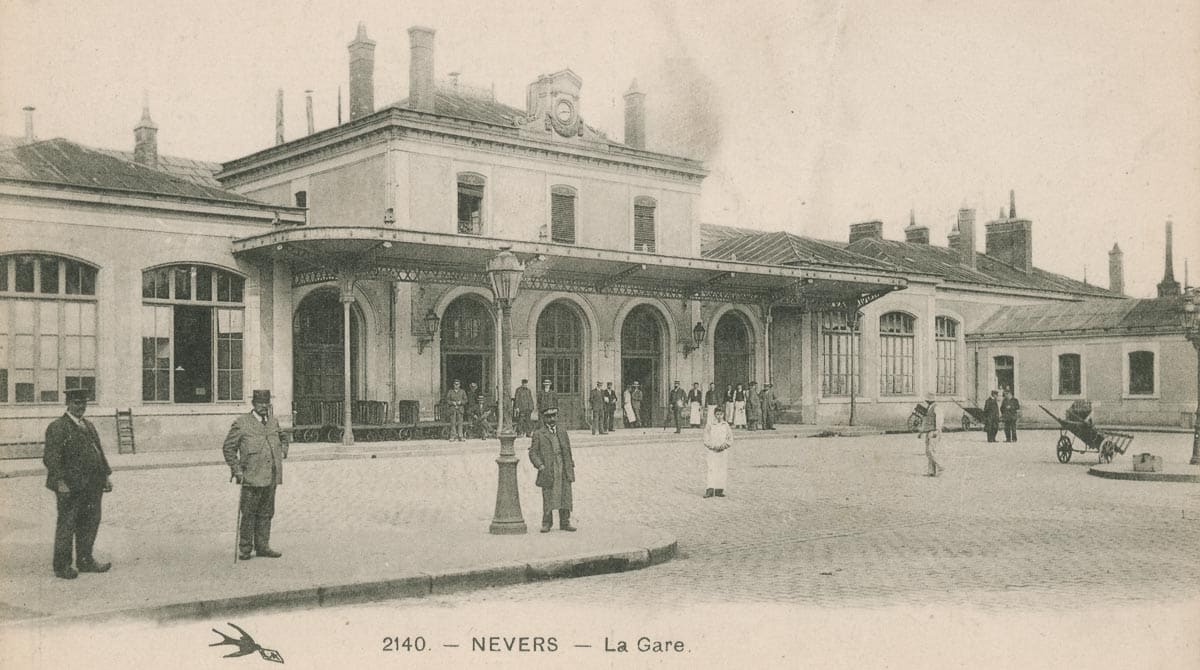
Nevers was also a garrison town for the French army. The first barracks date from 1777. In 1887, the barracks were renamed Caserne Pittié, named after General François Pittié (1829–1886), who was a native of Nevers. The barracks housed the 13e Régiment d’Infanterie, also known as 13e de Ligne, from 1883 until its dissolution in 19404. Another part of this regiment was housed in the Caserne Charbonnier in nearby Decize. The regiment left for the battlefield in August 1914 and would distinguish itself on various battlefields during the war, including the Battle of Verdun in 1916.
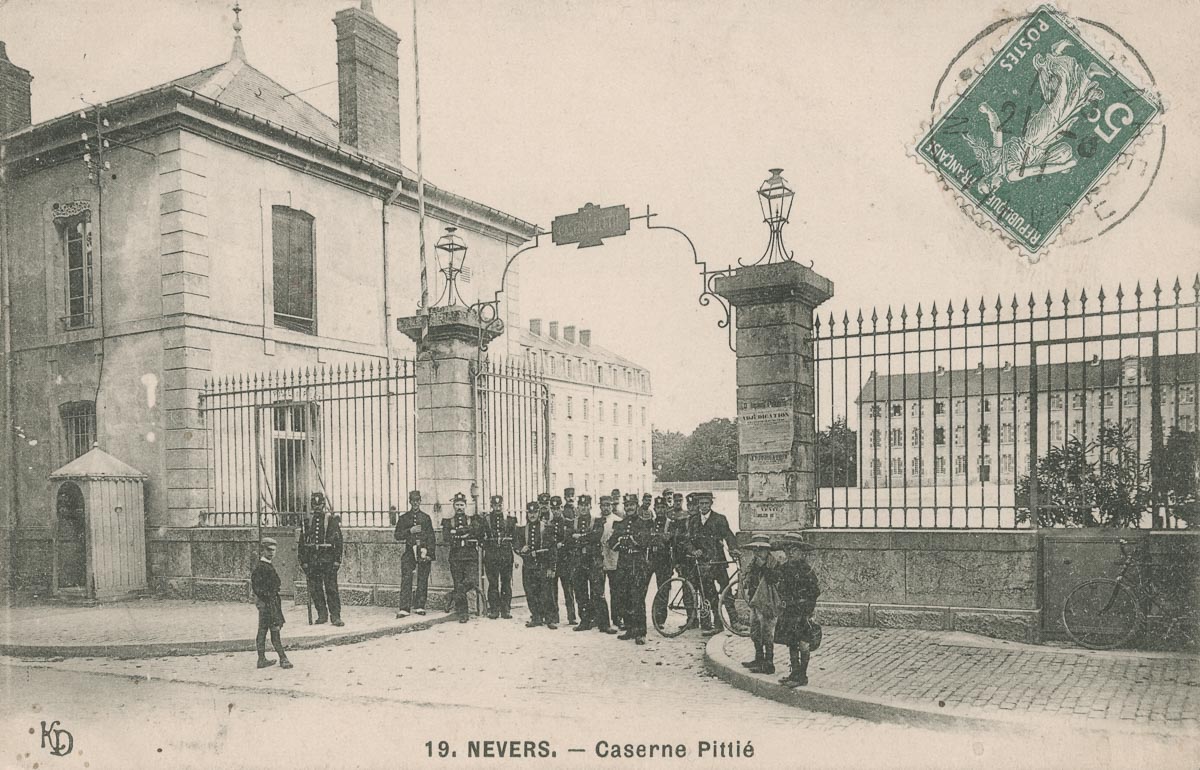
After the outbreak of the First World war, Nevers contributed to the war effort by producing weaponry by the local industry and hosting refugees and wounded soldiers. Several (temporary) hospitals were created to care for the injured, and the building of the Atelier du matériel de Nevers was used by the British Red Cross. There was also a prisoner of war camp in Nevers.
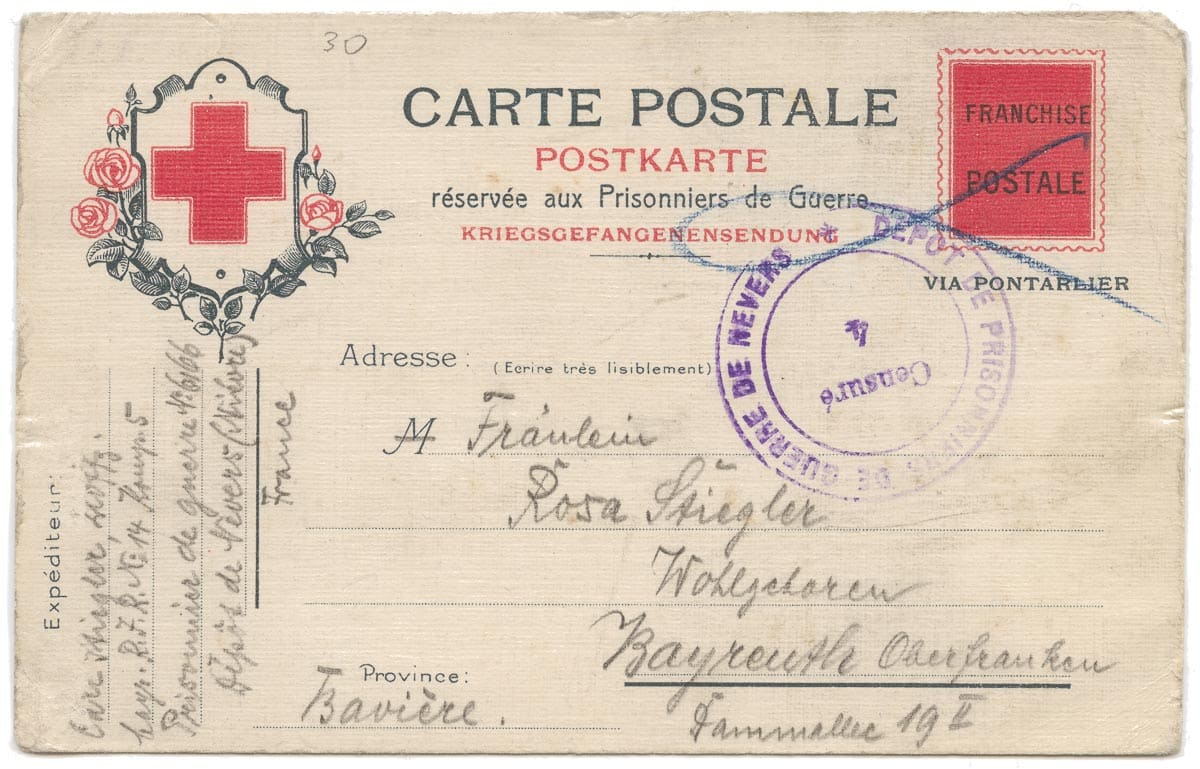
24 November 1918
The horrors of the battlefields and enemy occupation were not experienced by the city, but shortages and high prices caused social unrest, leading occasionally to strikes5. In July 1917, American troops arrived in Nevers, after the United States had joined the Allied side. The Americans built the extensive Mesves hospital with 10,000 beds6. They also built the Nevers cut-off, a railway line and bridge over the Loire that bypassed the station and the city. This shortcut was built in four months and completed in October 1918, just before the end of the war. The shortcut was used until August 1919 for the evacuation of troops and dismantled afterwards.7.
The images
The collection shows the mobilisation and onboarding of soldiers at Nevers station, including the departure of Never’s 13th Infantry Regiment.
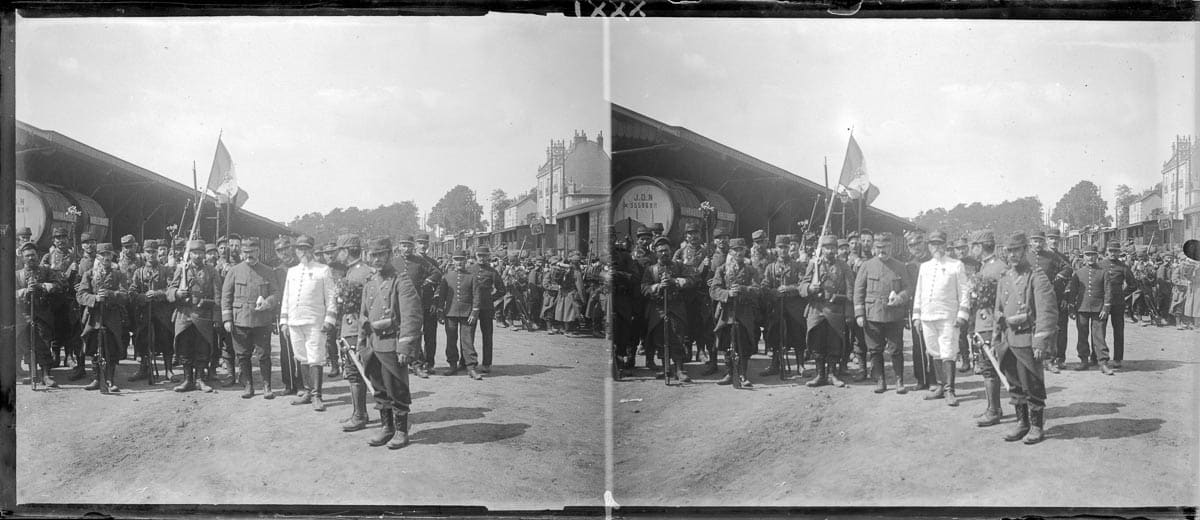
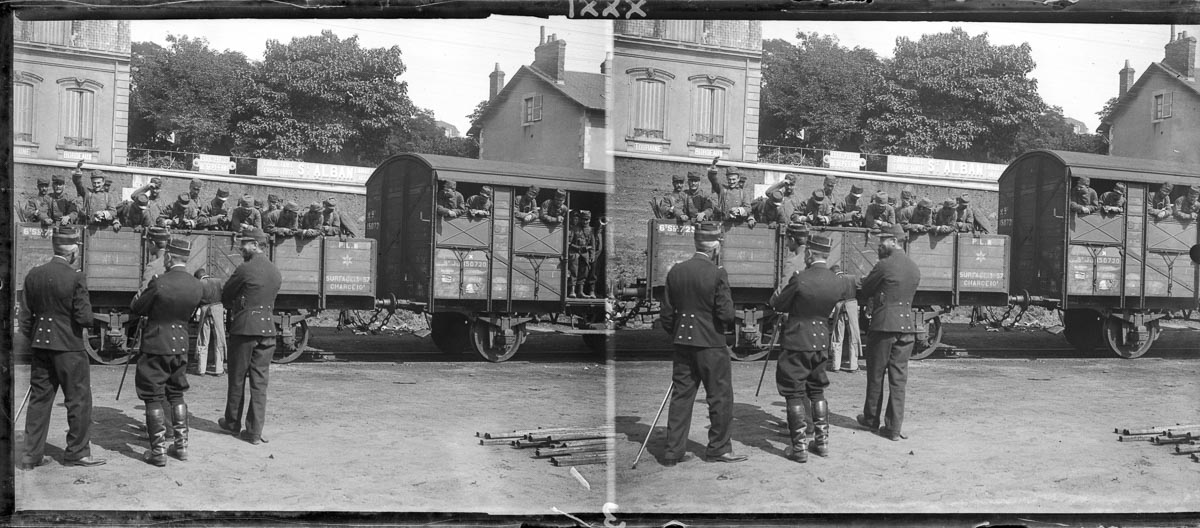
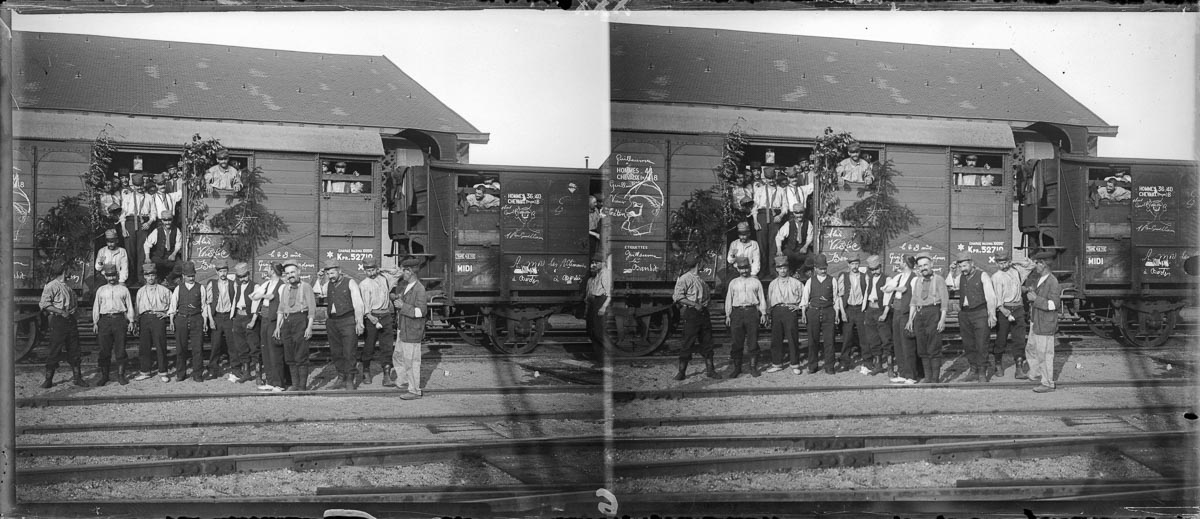
The atmosphere at the station is friendly and relaxed. The war was welcomed by all countries, and the horrors of trench war were still far away. Texts and images are painted on some wagons, such as a caricature of the German Emperor Wilhelm II, who is called a bandit (“Guillaume Bandit”).
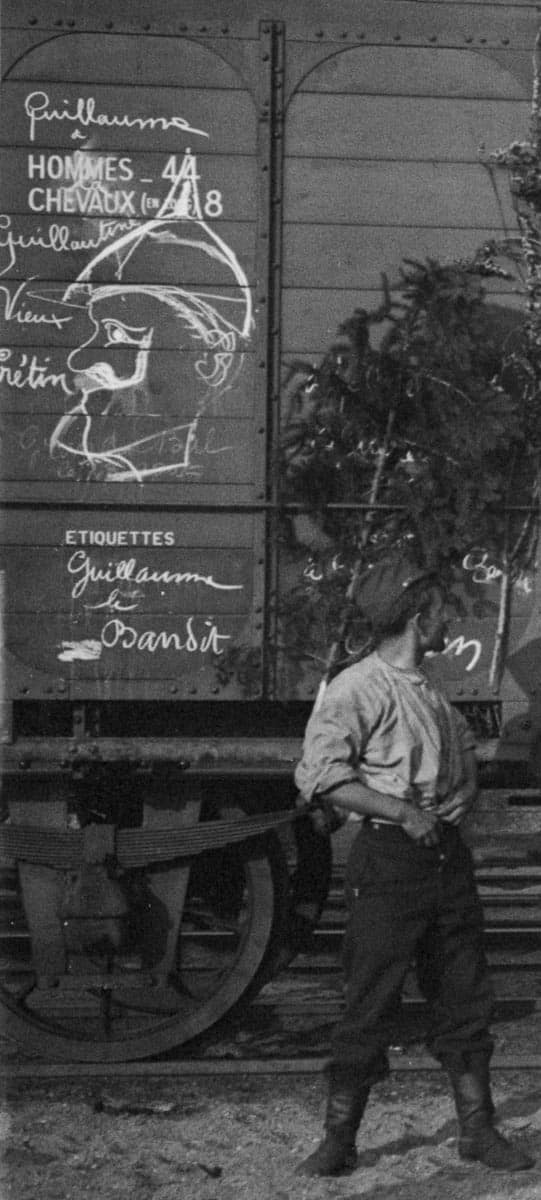
Some photos show soldiers from the French colonies. The Zouaves and Tirailleurs were regiments consisting of soldiers from the French colonies in North Africa, such as Senegal and Algeria. These regiments became more important from 1915, after the French army had suffered major losses in the first year of the war. These photos show that colonial soldiers were already present in the early days of the conflict.
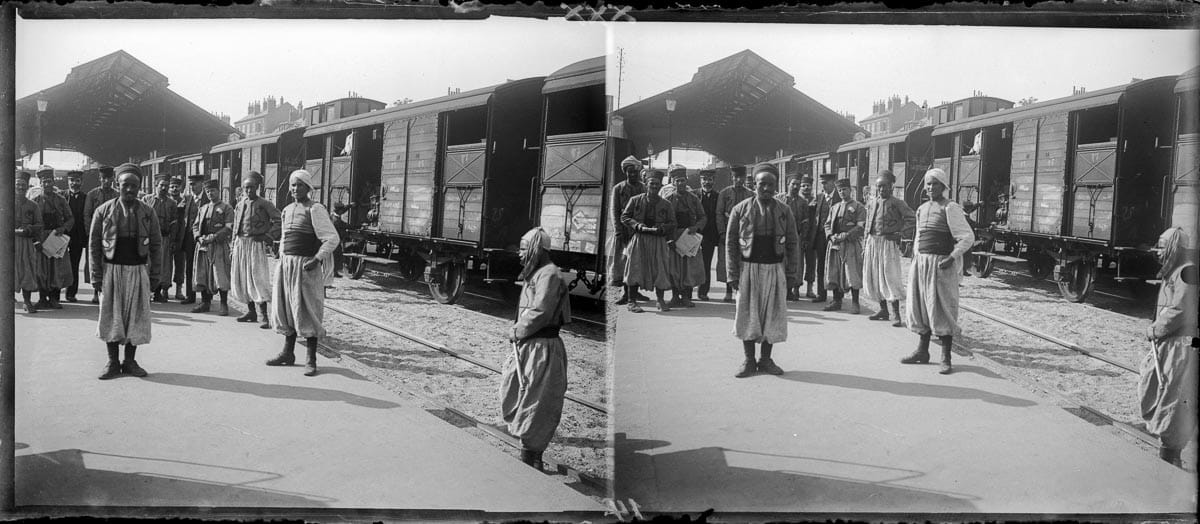
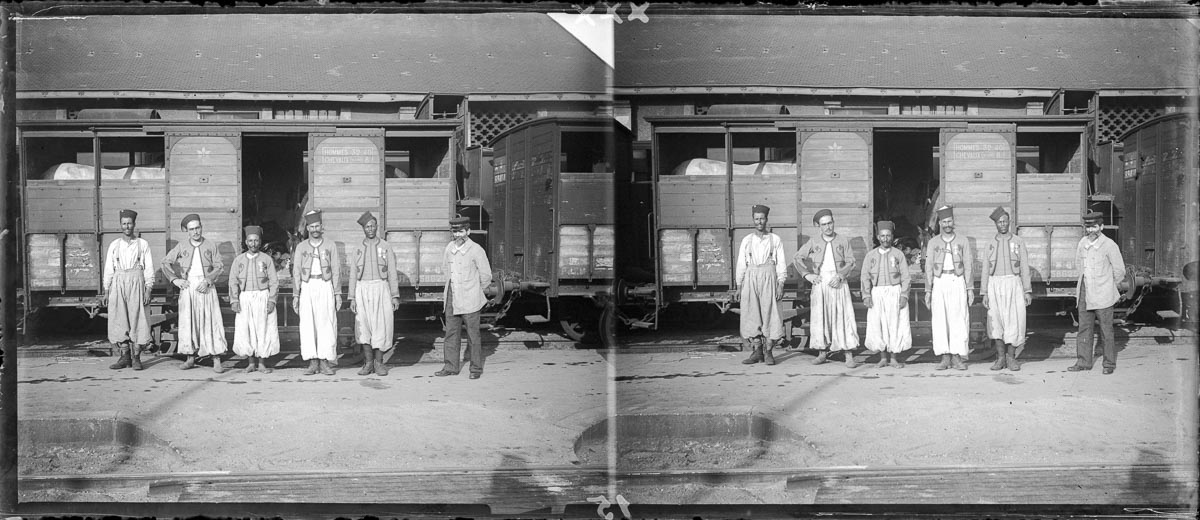
Finally a photo of German prisoners of war in a wagon, guarded by French soldiers. After the Battle of the Marne and the Race to the Sea, the front turned into a static trench war that would last until 11 November 1918.
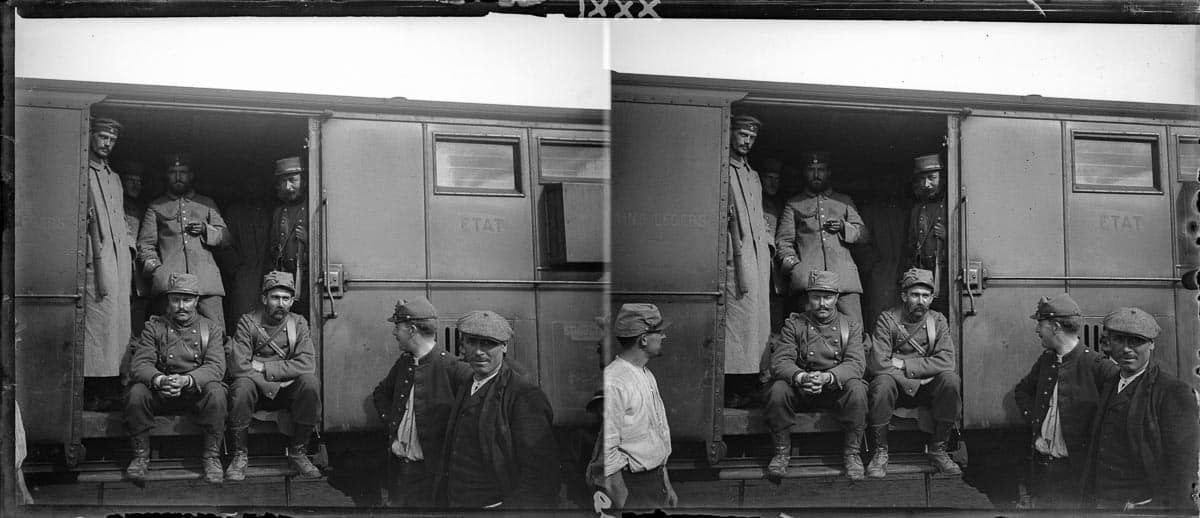
The photographer
The name of the photographer of the images in the collection is unknown, but he might have been a professional photographer. The large 8 x 18 cm negatives required a large expensive camera and skills to operate it, which is less obvious to an amateur. In addition, all negatives are accurately indexed and preserved, which indicates the work of a professional. More negatives from the same photographer were offered by the seller on eBay. These did not contain images of the war, but were all indexed in the same way.
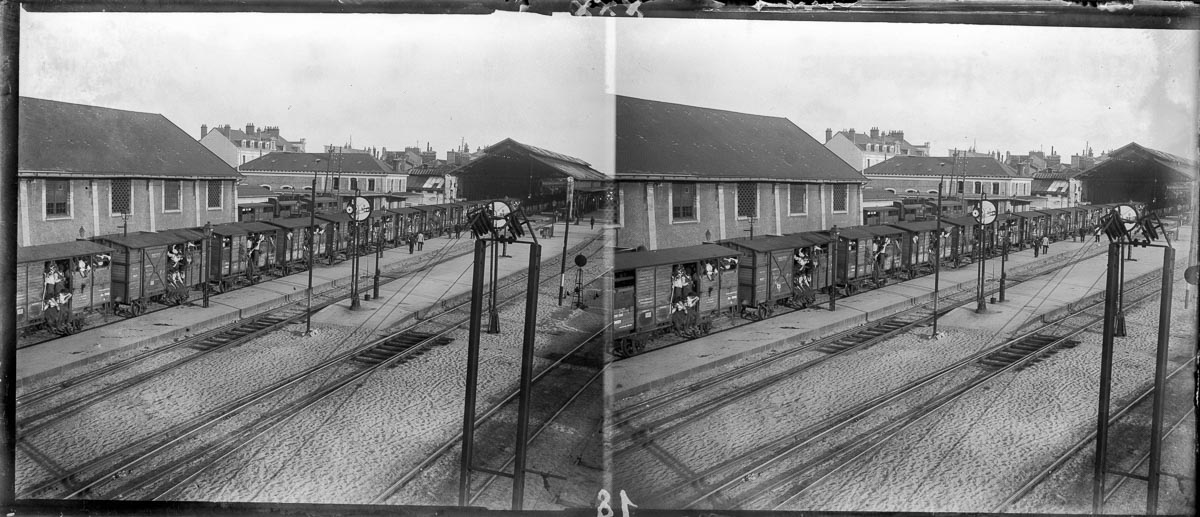
The photographer was probably from Nevers or the surrounding area, as the photos were taken on different days in August and October. A local photographer could be on site quickly. Maybe the photographer was a journalist, but it is also possible that he was hired by the French army. Many photos were staged, which indicates that the photographer had permission to shoot. The First World War was the first major conflict in which photography played an important role. In May 1915, the French army founded its own photography section, La Section Photographie de l’Armée. This unit produced 120,000 photos during the conflict, including 20,000 stereo photos. Before the creation of the SPA, the French Army may have simply hired professional photographers to capture the mobilisation for documentation or to inform the public by newspapers.
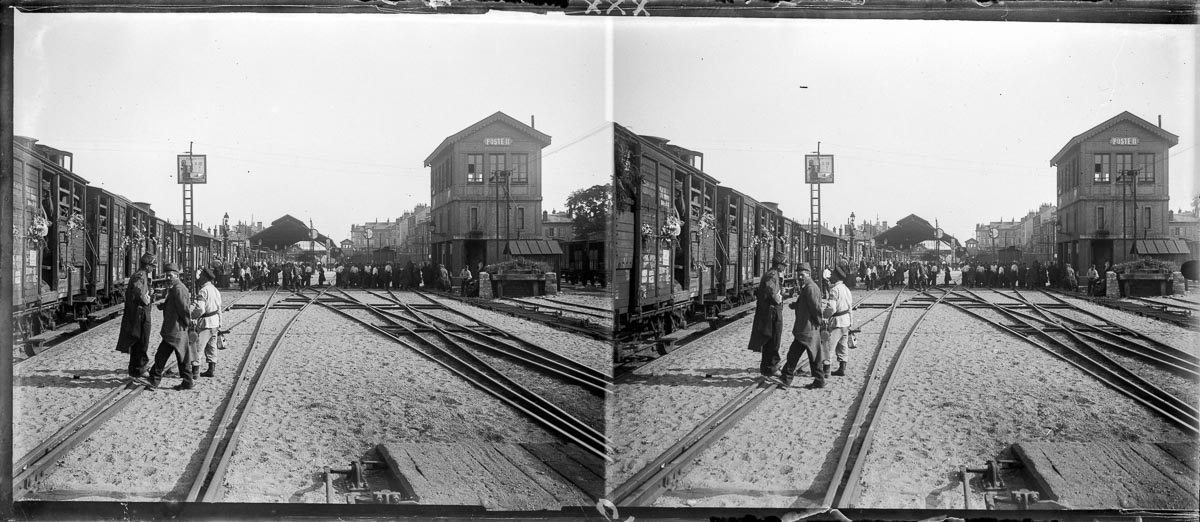
But why did the photographer use a stereo camera? Stereoviews were primarily intended for entertainment and not necessarily for publication in albums or newspapers. Maybe this was the only camera the photographer had, and the large size of the negatives made it possible to use half stereos to make good quality prints.
Epilogue
Digital scans of the images in this collection have been shared with the Archives Départementales de la Nièvre in 2021. They were very happy with the images. In 2014, a memorial plaque was unveiled at the station of Nevers, as a reminder of the mobilisation and the departure of the 13th Infantry Regiment. However, the city had no photographic material of this event. The shared images are now a welcome addition to the archives of the Nièvre department and the city of Nevers.
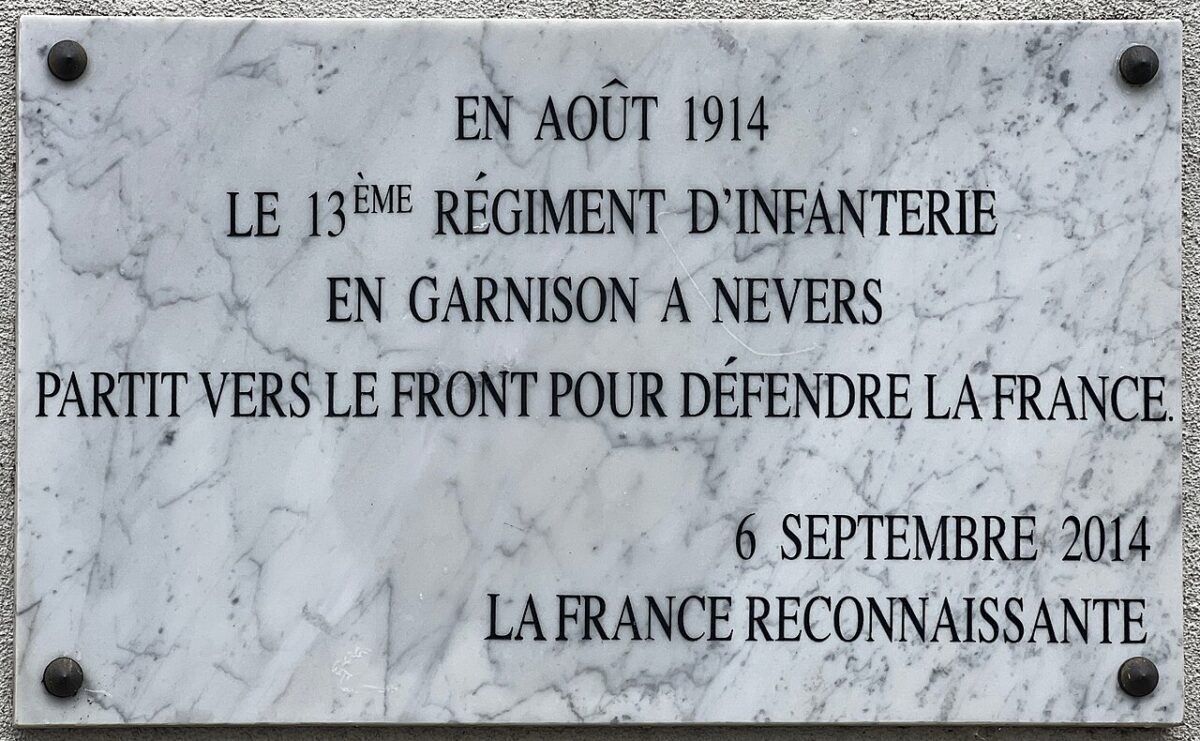
Source: Wikimedia Commons
References
- Nevers. Via: en.wikipedia.org ↩︎
- Gare de Nevers. Via: fr.wikipedia.org ↩︎
- Ibid ↩︎
- Ancienne caserne Pittié de Nevers. Via: fr.wikipedia.org ↩︎
- Charrier, J.B. (1984) Histoire de Nevers, pp. 329-332 ↩︎
- Ibid ↩︎
- Histoires 14-18 : le cut-off de Nevers. Via: france3-regions.francetvinfo.fr ↩︎
